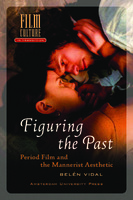Figuring the Past
Period Film and the Mannerist aesthetic
| dc.contributor.author | Vidal, Belén | |
| dc.date.accessioned | 2012-12-31 23:55:55 | |
| dc.date.accessioned | 2019-12-10 14:46:32 | |
| dc.date.accessioned | 2020-04-01T15:17:41Z | |
| dc.date.available | 2020-04-01T15:17:41Z | |
| dc.date.issued | 2012 | |
| dc.identifier | 426536 | |
| dc.identifier | OCN: 815380396 | en_US |
| dc.identifier.uri | http://library.oapen.org/handle/20.500.12657/34467 | |
| dc.description.abstract | This definitive work offers a new approach to the period film at the turn of the twenty-first century, examining the ways in which contemporary cinema recreates the historical past. This book explores the relation between visual motifs and cultural representation in a range of key films by James Ivory, Martin Scorsese and Jane Campion, among others. Looking at the mannerist taste for citation, detail and stylisation, the author argues for an aesthetic of fragments and figures central to the period film as an international genre. Three key figures - the house, the tableau and the letter - structure a critical journey through a selection of detailed case studies, in relation to changing notions of visual style, melodrama, and gender. This seeks to place this popular but often undervalued genre in a new light and to rethink its significance in the context of key debates in film studies. | |
| dc.language | English | |
| dc.relation.ispartofseries | Film Culture in Transition | |
| dc.subject.classification | thema EDItEUR::A The Arts::AT Performing arts::ATF Films, cinema | en_US |
| dc.subject.classification | thema EDItEUR::A The Arts::AT Performing arts::ATJ Television | en_US |
| dc.subject.other | motion pictures | |
| dc.subject.other | film | |
| dc.subject.other | Historical period drama | |
| dc.subject.other | Mannerism | |
| dc.subject.other | Melodrama | |
| dc.title | Figuring the Past | |
| dc.title.alternative | Period Film and the Mannerist aesthetic | |
| dc.type | book | |
| oapen.abstract.otherlanguage | Figuring the Past geeft een nieuwe kijk op kostuumdrama's die aan het begin van deze eeuw gemaakt zijn en onderzoekt de manieren waarop de hedendaagse cinema het historische verleden herschept. De auteur verkent de relatie tussen visuele motieven en culturele representaties in een aantal belangrijke films van onder anderen James Ivory, Martin Scorsese en Jane Campion. Door te kijken naar de maniëristische voorkeur voor citatie, detail en stilering, pleit de auteur voor een esthetiek van fragmenten en figuren die centraal staan in de historische kostuumdrama's als een internationaal genre. In gedetailleerde casestudies worden drie belangrijke kenmerken van het genre - het huis, het tableau en de brief - in relatie gebracht met de veranderende begrippen van visuele stijl, melodrama en geslacht. | |
| oapen.identifier.doi | 10.26530/OAPEN_426536 | |
| oapen.relation.isPublishedBy | dd3d1a33-0ac2-4cfe-a101-355ae1bd857a | |
| oapen.relation.isbn | 9789089642820 | |
| oapen.pages | 256 | |
| oapen.remark.public | Relevant Wikipedia pages: Historical period drama - https://en.wikipedia.org/wiki/Historical_period_drama; Mannerism - https://en.wikipedia.org/wiki/Mannerism; Melodrama - https://en.wikipedia.org/wiki/Melodrama | |
| oapen.identifier.ocn | 815380396 |

